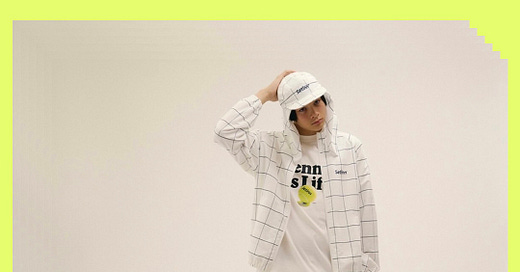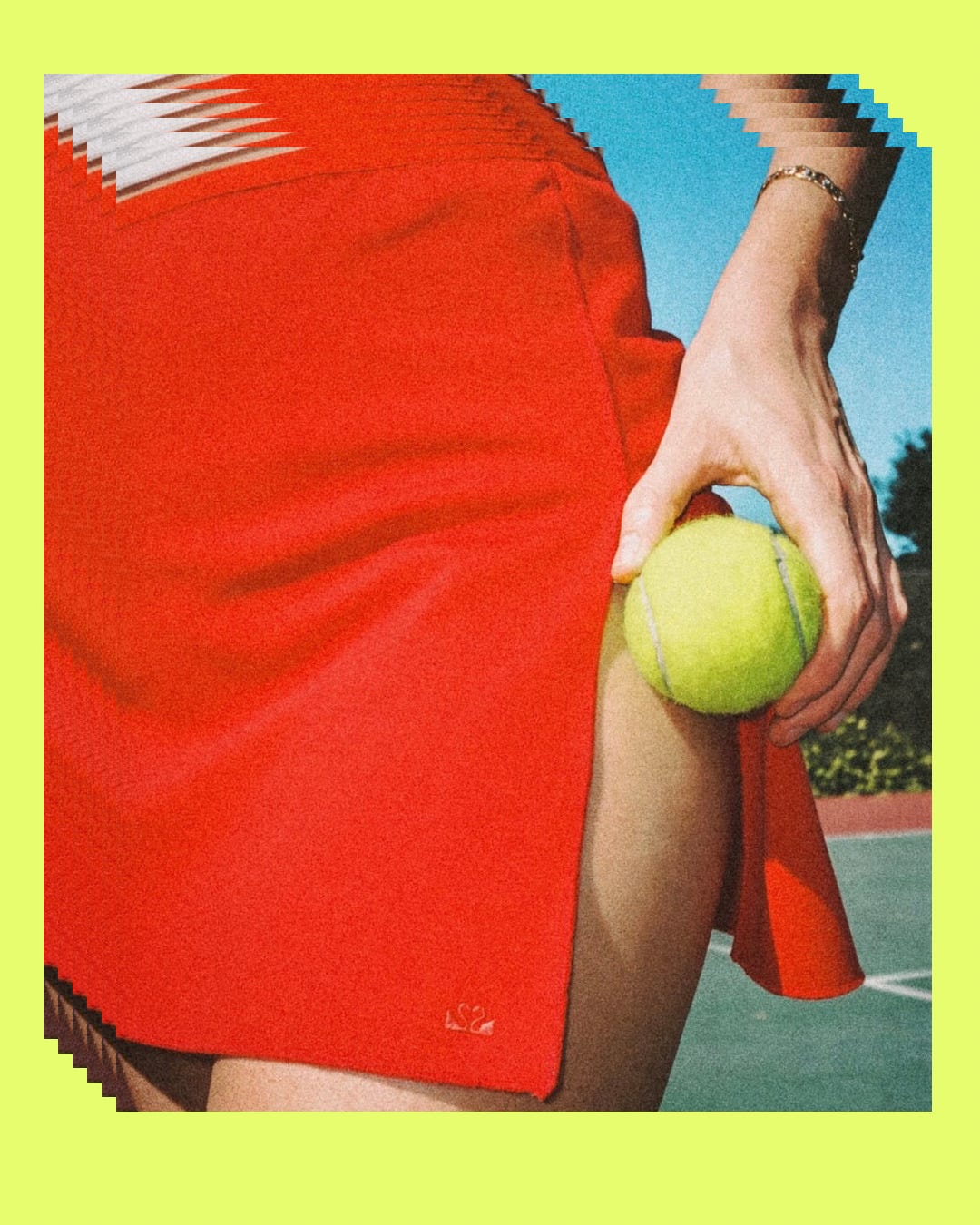I often joke that I spend more time in workout clothes than actual clothes. Soon, I might not need to distinguish between the two. There’s a fast-developing overlap where performance clothes look like normal clothes, and they’re actually designed to be worn that way too. It’s not athleisure. It’s activewear, designed to actively be worn — anywhere.
From Satisfy, Bandit, Horse Sport and Literary Sport to tennis brands Spence and Setinn, there now exists kits that cater to the hybrid lifestyle. Even leggings, which have stayed the same silhouette since forever, have evolved into shapes that are less obviously gym, including flares and capri-length tights. That’s a trend I’m going to dig into properly in a forthcoming post; I chatted to Marie Fredros, head of design at H&M Move, about it at a pilates class recently. I was interested by how many runway collections she cited as inspiration.
OK, but leggings aren’t “real” clothes.
Right. Except now, they kinda look like them, which proves the point. In fashion, kick-flare pants are back, and flared leggings are more passable as trousers than a full fitted tight. We’re in the next generation of leggings.
Another example: my search for the perfect tennis-style skirt. I had planned on buying a white cotton-twill version from Sporty & Rich for £110 on Net-a-Porter — a definite fashion item that I thought would be cute with a cashmere sweater.
Then I saw this £65 actual tennis skirt from Lululemon, in black. But it wasn’t your average boxy-pleat skirt. The Lululemon one has tiny folds that evoke Issey Miyake’s Pleats Please fabrics. It actually looks more like a fashion skirt than most actual fashion tennis skirts. Often, luxury brands, obsessed with all things #core, can skew too cosplay. Net-a-Porter’s styling of this Bode skirt perfectly illustrates that point. Sometimes, fashion tries too hard. Contrast that with Setinn, the new Japanese tennis brand by Beams buyer Shingo Arai (@sng1980). The label evokes the cool prep of Aime Leon Dore, Beams and Drake’s with its styling.
Note: this is not about sportscore.
It’s about fashionable utility. I’ve barely taken my Lulu skirt off. For its first outing, I styled it with Paraboot pony skin loafers, white ankle socks and a denim jacket; I’ve also worn it more casually, with my Nike Air Rifts and a Tracksmith cotton cap. I’ve lost count on the number of compliments it’s had. It’s an objectively nice skirt, sure — but anyone who’s commented on it has endured me waxing on about the performance elements. The fact it’s designed for sport means it has in-built bike shorts for coverage (no risk of knicker flash) and a side pocket in the shorts for your phone. The skirt hides the phone, which saves the clunkiness of putting it in a skirt or trouser pocket. I also think it’s less likely to get stolen from there than if it was in an actual pocket.
I can’t think of a single fashion item that I own that is as thoughtfully designed or as easy to wear.
So what?
This skirt is a good example of how sports brands—forever problem-solving—are looking to meet the needs of customers. Fitness is a lifestyle now, and clothes need to cater; brands are thinking of ways outside the box to do so.
“There’s a lot of room for new possibilities in the athletic category, as sport is fully integrated into our lives,” says Amanda Greeley, co-founder of the new US tennis brand Spence, which has a retro prep aesthetic that is cool both on and off-court. “Athleisure implies laziness,” she says, so Spence not that. If designers are smart, “it’s possible to create fully functional athletic clothing that allows the wearer to feel put together.”
The blurry boundary is an exciting space; the fact a big brand like Lulu is already entering the chat shows the likelihood of amplification. Venus Williams’ “tennis couture” Met Gala look, made by Lacoste, also repositions the pleated performance skirt as a noteworthy fashion (or in fact, red carpet) staple.
IT’S ABOUT FASHIONABLE UTILITY
I’m quite obsessed with Spence. I’ve not tried the kit yet, but aesthetically it speaks to this hybrid need. The tennis skirts are A-line, with a cute front split that are trendy right now; I appreciate the slimline waistband, which doesn’t have ruching or heavy elastics like a lot of sports clothing.
It seems I’m the target customer. “We wanted to create a go-to, pull-on mini skirt that works for just about anything,” says Greeley. She says the cotton-spandex pique fabrication, which has a texture, makes it “better paired with sweaters and button-down shirts off-court” — shiny nylons ordinarily look very flammable against a supple knit. Spence’s skirt doesn’t have those in-built shorts that I love, but you can buy matching knickers that have a pocket in — and sorry, but why doesn’t normal underwear have pockets?
What about menswear?
Given almost every major brand begins with a men’s line first, naturally, there’s noise here too.
Spence’s tennis shorts aesthetically speak to the guy who might wear a Patagonia cotton baggy short on repeat in summer. Except these ones have a smart, sports-led fabrication. They’re made using a lightweight crepe stretch taffeta, which is milled in Japan and has a nice matte texture; it’s also quick-dry and water-repellent. “The mission was to create a better baggy,” says Greeley. “Men’s performance shorts ordinarily don’t translate beyond the gym.” You can’t wear Patagonia ones to work out in, but you can wear Spence’s basically anywhere.
Satisfy is an obvious leader. It just dropped a ribbed fitted Auralite T-shirt that also looks reminiscent of Issey Miyake — texture in performance wear is something I’m taking note of. Satisfy has also developed technical plaid shirts and smart, button-down cowboy versions that are made from its Peaceshell fabric. The fit is boxy and, in chocolate brown and cream colours, it looks like a shirt you could find in Our Legacy or Acne Studios. To all intents and purposes, it’s just a great shirt for guys to wear to work.
But, designed for the trails, the fabric is moisture-wicking, abrasion-resistant and quick-drying, and the shirt comes with a pocket on the back designed for putting ice in — useful during a desert ultra, sure, but also handy during a 40-celsius London or New York summer. I’m joining the Satisfy team in Wyoming this week to run around a ranch and test out the forthcoming kit in a day-to-dark, multi-use context. I’ll report back.
What else is out there?
Literary Sport’s aesthetic quietness really sings. The brand’s waffle merino wool tops for men and women fit right into a Cucinelli-wearers wardrobe; they’re actually very dressy and feel very far removed from sportswear. Jackie McKeown, Literary Sport’s design director, says she’s “heavily inspired by The Row,” which makes sense. In brand terms, Literary Sport is an introvert in an industry of brightly-coloured extroverts. I do think this buys LS longevity distinct from the noisy, hype brands. And, the fact the tops are genuinely multi-wear means it’s possibly easier to justify splashing out; LS is one of the most expensive brands on the market.
I think the mesh merinos are the most interesting item that LS offers. The bras and shorts are lovely for those who prefer more muted palettes, but those meshy tops will become its golden ticket. They’re genuinely nice enough, and smart enough, to wear to meetings all day with trousers, but you can shove a pair of shorts in your bag to go for a run afterwards. Anything that helps reduce the amount of kit you need to carry around is, to me, gold.
Here I am with it draped around my shoulders in Ibiza at Cafe del Mar. Everything I’m wearing in this photo is sportswear… my tank is from Pruzan and the skirt is Lululemon.
Full disclosure: I was given this merino to wear for a panel talk I hosted with Literary Sport at Knees Up in Hackney. I wore it then with a silk slip skirt. I do still think it’s quite wild that the entire panel was wearing LS sports kit but we looked dressed for a cocktail. Judging by the amount I’ve worn it, and the fact it’s multi-use, I would spend the $345 on it personally.
How else is all this relevant?
Climate change means designers of all industries are going to have to create solutions that counter the effects. Clothes and sports brands are no exception; Satisfy’s ice pocket is a very smart place to start.
Considering I spend most summers training for a marathon these days, I spend most of my time in a gym kit in hot weather. But what I also find is that often, on non-run days, I’ll just get dressed in sportswear anyway as it’s more bearable to wear when London or New York is horrendously hot. One piece I opt for on repeat is Pruzan’s £50 sleeveless tank, which is made from a silky fabric that looks like a very dressy top but is a lot thinner and more breathable than a cotton tank top. I also own the long-sleeve crop, and I wear this with jeans all the time.
Summers are generally getting hotter; London recorded its highest ever May 1 temperature, hitting 29.3 celsius. January 2025 was globally the hottest ever also, according to data from the European Commission. But it’s not all about sweat. Winters are getting colder; hotter temperatures disrupt the Arctic wind flow.
Why does that matter?
Fabrics like merino wool—the original sportswear fibre—which is thermoregulating and keeps you warm in cold weather, and cool in hot, will become necessary. At the moment, few sports brands actually use merino in their collections; I have versions from Tracksmith, Literary Sport and Soar. I have one from On, too, but that’s since been discontinued. From a planet-health perspective, we’ll see much more merino in the future s it’s a natural material. It will become more prominent still as sportswear continues down this path of looking like ordinary clothes, as merino is inherently off-duty in appearance.
Let’s hope brands in the future don’t cover their merino tops in a load of logos. Although on TikTok, there’s a trend going round showing how you can remove Alo Yoga logos with acetate. As with all things design, where there’s a solution-focused will, there’s a way.
Can all sportswear translate?
Apparently not. I find it interesting that cycling really hasn’t entered the fashioncore space beyond a bike short. Basketball jerseys, rugby tops, cricket sweaters, ballet cardigans, even jodphurs; at some point or other, signature silhouettes from most sports have become commonplace in our wardrobes as clothing. I’ve yet to see anyone rock a fitted half-zip out of a saddle. Thoughts on why bikecore has yet to happen? Email me on saltysubstack@gmail.com.











Not sure if this is a valid take, but being in the running space it seems brands like Satisfy are pushing running fashion with streetwear inspired looks— and on the flip side, as you mentioned, people are looking to sportswear for their everyday style. I feel as though my run style and general style are the same exact thing nowadays!